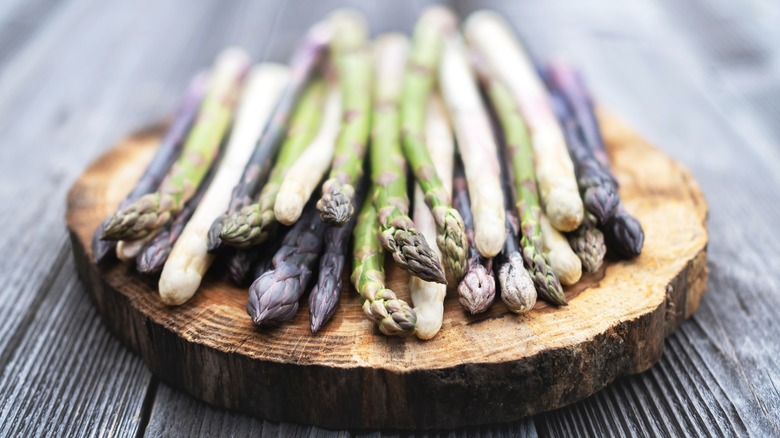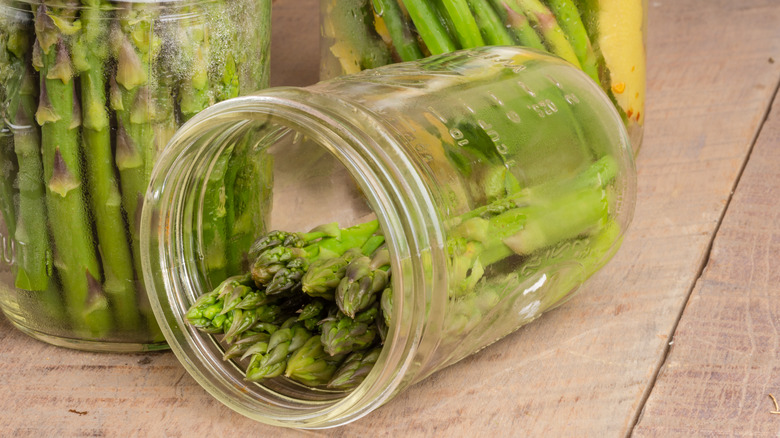3 Simple Tips For Choosing The Best Bunch Of Asparagus
Some vegetables are just inherently delicious basically right out of the ground, shining in even the simplest dishes. Take balsamic-marinated asparagus as a prime example, or lightly seasoned and oiled asparagus spears roasted in the toaster oven. Asparagus has its own earthy-green sweetness and slightly firm texture that makes it a favorite among celebrity chefs. This means, of course, that you need to be just as choosy about buying your asparagus as you are when picking out the perfect recipe — sometimes, these guys can be woody or taste bitter. There are three simple tips for choosing the best bunch of asparagus, and simply put, they consist of trusting your senses of sight, touch, and taste.
Use your eyes to determine if the asparagus' color is bright and that its tips are tightly closed (like a spear point, natch) and not beginning to leaf out. Use your hands to see if an individual stalk breaks with a pleasing snap, or is instead floppy and lifeless. Lastly, use your taste buds (with your grocers' permission if you don't wan't to be a renegade) to take a bite of raw asparagus — you're looking for sweet and crunchy, not bitter and soft.
Size and color considerations
Contrary to what you might have heard, the size of the asparagus spears is not an indication of age but rather the age of the plant crown they sprouted from. (It is true that older stalks can be tough; you determine this by looking at whether the tips have started to look like leafy ferns.) So, the size of your asparagus should instead be determined by how you want to cook it: grilled asparagus is divine, no doubt — but thinner stalks are more likely to slip through the grill grate and become carbonized. Conversely, if you're looking for a delicate side that needs only a light blanch, go for a thinner bunch. The only size consideration when choosing a bunch of asparagus is uniformity, because you don't want one thinner stalk that is juicy and tender while a nearby thicc boi has yet to cook out.
As with the size of the stalks, the color of your asparagus is also a matter of personal preference. Purple asparagus tends to be tenderer than its green brethren, with a pronounced sweetness thanks to its higher sugar content, while white asparagus is typically the mildest in flavor with a more robust texture. Regardless, the three-senses criteria still applies to buying these other types.
Buy seasonally, store correctly
Like any vegetable, asparagus has its season — in this case, spring (typically from late March to June). Like any other vegetable, you'll want to buy fresh asparagus for several reasons: The first is freshness — you'll want these guys are freshly harvested as possible for maximal juiciness; secondly, while it might be true that you can find asparagus year-round in the grocery store, it's likely been shipped in from far away; which brings us to the third reason, price — it costs money to truck that woody old asparagus from elsewhere, and that expense is sure to be passed on to you.
Once you get your fresh, crisp, and sweet asparagus home, you'll want to store it correctly. Simply moisten a paper towel, wrap it around your asparagus, and stick the bundle in an open container or plastic storage bag. Keeping the bag open or the lid off is essential for freshness and airflow. One particularly clever solution is to use the mason jar hack to extend the life of your asparagus. It works by treating the vegetable as you would a bunch of fresh flowers, by lightly trimming the bottom ends and putting them in water as soon as possible. Store your asparagus bag or jar in the fridge until its time to blanch, steam, roast, sauté, or grill it to perfection.


